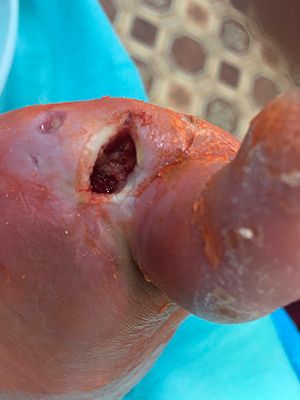- Usage
- Usage Cases
- Diabetes
Case №50
Diabetes. Condition after amputation of the big toe of the right foot
Attending physician: Mishchenko Sergei Alexandrovich
Lugansk hospital
-
Patient:
Men
-
Age:
67 years old
-
Diagnosis:
Diabetes
Diabetes
Diabetes, a chronic disease that can lead to cardiovascular disease, blindness, kidney failure, loss of limbs and death, is preventable.
Diabetes causes suffering and hardship to the approximately 60 million people in the European Region who are currently living with the disease, and also places a strain on the economy and health systems of the Region.
The prevalence of diabetes in the European Region is increasing, reaching 10–12% of the population in some Member States. This increase is closely related to increasing trends in overweight and obesity, unhealthy diets, physical inactivity and socioeconomic status. These risk factors also contribute to the development of three other noncommunicable diseases (NCDs) that have become international public health priorities (cardiovascular diseases, chronic respiratory diseases and cancer), so it is imperative that diabetes prevention is integrated into population approaches to prevention. NIH as a group.
What is diabetes?
Type 1 diabetes
Type 1 diabetes is characterized by an insulin deficiency and requires daily insulin administration. With current knowledge, type 1 diabetes cannot be prevented.
Symptoms include excessive urination (polyuria), thirst (polydipsia), constant hunger, weight loss, vision changes, and fatigue. These symptoms can come on suddenly and the disease can manifest itself in an acute form.
Type 2 diabetes mellitus
Type 2 diabetes occurs as a result of the body's ineffective use of insulin (insulin resistance). It accounts for 90% of people with diabetes worldwide and is largely preventable. Being overweight, especially around the waist, physical inactivity, and high intake of saturated fatty acids independently increase the risk of insulin resistance. This risk increases even with a slight increase in weight within the normal range (body mass index below 25). The development of type 2 diabetes has also been associated with other factors such as ethnicity, early childhood experience and influence, and socioeconomic factors.
Symptoms can be similar to those of type 1 diabetes, but are often less severe. As a result, the disease can be diagnosed several years after the onset, when complications have already arisen.
Until recently, type 2 diabetes was considered a disease of middle-aged and elderly people, but its incidence has increased in all age groups, and now it is increasingly common in adolescence and childhood.
Impaired glucose tolerance (IGT) and impaired fasting glycemia (IFG) are intermediate conditions in the transition from normal to diabetes. People with IGT or IFG are at high risk of developing type 2 diabetes, although this is not inevitable.
In later stages, diabetes leads to irreversible consequences, such as: diabetic foot syndrome, gangrene and amputation of limbs, blindness, obesity.
Cooperate With Us
or via contact phones or email
-
Conveniently
By contacting only one supplier, our customers receive a wide range of products in the shortest possible time.
-
Simple
Our customers are only required to form an order for the supply of products, we will take care of all further tasks
-
Profitable
We save our customers money on import
and delivery taxes



